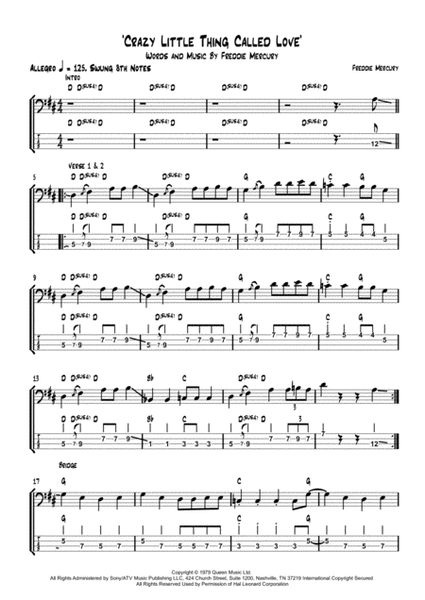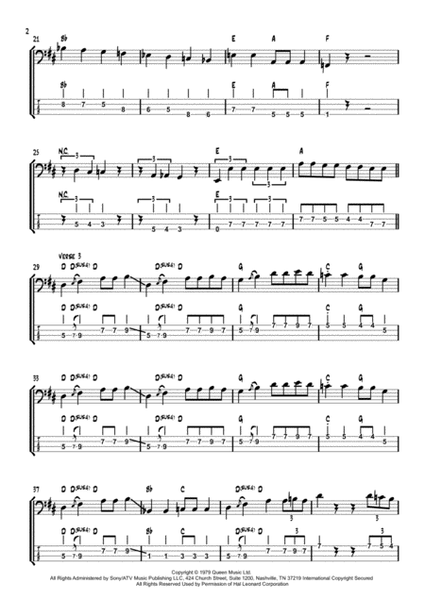Details
Description
SKU: A0.896157
By Dwight Yoakam. By Freddie Mercury and Frederick Mercury. Arranged by Antony Cull. A Cappella,Rock. Score. 4 pages. Antony Cull #3109721. Published by Antony Cull (A0.896157).'Crazy Little Thing Called Love' is single taken from Queen's album, 'The Game'. The bass line, like the the rest of the composition, is built round a 50's rock 'n' roll sound although there is some influence from soul and jazz in there for good measure. The rhythmic feel throughout is swung eight notes throughout with the occasional triplet fills and pushed chord changes. It is reasonably fast 125bpm so watch out for any fretboard jumps as there is the little time to change positions.
The verse's are built a round the transposing a major pentatonic walking pattern to each major chord. The short acciaccatura sliding into the third of each chord whilst not essential adds a lot of musicality and style to the line. This pattern is broken with a triplet fill in bar 15, which is quick and crosses onto the G string to end. In the third verse there is a quick chromatic fill into the Bb of the solo, treat this as an anacrusis (pick-up) for that section in practice.
The bridge starts with walking around the 1st, 5th and 6th of the G and C before playing a descending Bb major scale from the D string. He plays root notes through the E, A and F chords before playing the iconic crotchet triplet break. Missing the first beat of a triplet can be tricky for beginner players so practice full crotchet triplets before removing the first beat. I would start with a single note to focus on the rhythm and then introduce the chromatic run. To end this section play the crotchet triplets under the E chord before descending, with quavers, down the D major scale.
Whilst the guitars tackle the solo the bass finds itself playing a pattern similar to the bridge but with the first four bars substituted. It starts by playing around the Bb with the 1st, 5th and 6th similar to the verse although watch out for the push. During the D, G, D bars we get some more walking up to G and playing around the 1st, 5th and octave of the to set up the descending Bb major run. Play the rest of the guitar solo similar that of the bridge until the E chord. Replace these humble root notes with an E major scale run to the A. The forth verse is acapella with the exception of the final fill. Staring on the second swung quaver is about developing a strong sense of the pulse, start with a muted note on beat one and gradually remove it till the rhythm feels natural.
The fifth verse and Coda starts out the same as previous verses. As the final four bars of the verse are repeated for the coda the bass walks around a lot more. Start out learning the walking pattern exact, focusing on changing position before building your own lines.
Any question as always come visit me at www.antonycull.co.uk and I will answer them. There is loads of other information on there about my own music and blog that may also interest you. Enjoy!
This product was created by a member of ArrangeMe, Hal Leonard’s global self-publishing community of independent composers, arrangers, and songwriters. ArrangeMe allows for the publication of unique arrangements of both popular titles and original compositions from a wide variety of voices and backgrounds.
Digital Downloads are downloadable sheet music files that can be viewed directly on your computer, tablet or mobile device. Once you download your digital sheet music, you can view and print it at home, school, or anywhere you want to make music, and you don’t have to be connected to the internet. Just purchase, download and play!
PLEASE NOTE: Your Digital Download will have a watermark at the bottom of each page that will include your name, purchase date and number of copies purchased. You are only authorized to print the number of copies that you have purchased. You may not digitally distribute or print more copies than purchased for use (i.e., you may not print or digitally distribute individual copies to friends or students).



 Share
Share